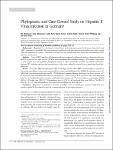Phylogenetic and case-control study on hepatitis E virus infection in Germany
Wichmann, Ole
Schimanski, Sven
Koch, Judith
Kohler, Martin
Rothe, Camilla
Plentz, Annelie
Jilg, Wolfgang
Stark, Klaus
Background: Hepatitis E is a classic water-borne disease in developing countries. In Germany, hepatitis E virus (HEV) infections are notifiable. The number of non–travel-associated infections has increased in recent years, but the route of transmission in most is unknown. Our objective was to determine risk factors for autochthonous HEV infections in Germany. Methods: Cases of HEV met clinical definitions and were confirmed by laboratory analysis (defined as detection of HEV by polymerase chain reaction [PCR] or immunoglobulinMby serologic testing). PCR products from blood or stool samples were genotyped for phylogenetic analysis. A case-control study included case subjects with autochthonous HEV infection and matched control subjects who were randomly recruited from a population-based telephone list. Results: From May 2006 through August 2007, 76 of 96 persons for whom HEV infection had been reported to the routine surveillance system were interviewed. Sixty-six persons had disease that fulfilled the inclusion criteria: 45 (68%) had autochthonous infection, and 21 (32%) had travel-associated disease. Genotypes 3 or 4 were present in 15 of 15 persons with autochthonous infection, and genotype 1 was present in 8 of 9 persons with travel-associated infection. In conditional logistic regression involving 45 case subjects and 135 control subjects, consumption of offal (41% vs. 19%; odds ratio [OR], 2.7; 95% confidence interval [CI], 1.2– 6.2) and wild-boar meat (20% vs. 7%; OR, 4.3; 95% CI, 1.2–15.9) were independently associated with autochthonous HEV infection. Conclusion: Hepatitis E is endemic in Germany and likely exists as a food-borne zoonosis. Implicated meat products should be investigated to provide recommendations for preventive measures.
Dateien zu dieser Publikation
Keine Lizenzangabe

